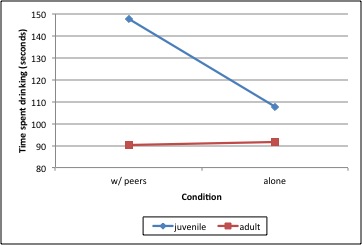Adolescence is a time of many changes, including some that set the stage for risky behavior. At the same time that youth have more opportunity to engage in risky behaviors, they are particularly sensitive to the actions and approval of their peers. Some research suggests that both risk-taking and sensitivity to peer influence are rooted in changes in the brain that occur during adolescence (Albert, Chein, & Steinberg, 2013). In relation to substance use and addiction, exposure to peers might increase risk for excessive substance use by enhancing adolescents’ sensitivity to reward and disinhibition. This week, the DRAM reviews a study that used animal models to test whether adolescents drink more in the presence of peers than alone (Logue, Chein, Gould, Holliday, & Steinberg, 2014).
Methods
- The sample included 86 mice (50% male).
- Half were tested in adolescence; half were tested as adults;
- Within each age group, mice were randomized to be tested either with two peers or alone.
- During the experiment, the mice had access to sipper tubes with an alcohol solution for 45 minutes; researchers measured their consumption and time spent drinking during that time period.
- Researchers measured the total time each mouse spent drinking, as well as the “duration of drinking bouts” – time spent drinking divided by number of distinct visits to sipper tubes, along with other outcomes, including general activity.
Results
- Analyses showed that adolescent mice spent more time drinking than adult mice.
- As Figure 1 shows, there was an interaction between age and condition – for adolescent mice, being in the presence of their peers increased their time spent drinking and the length of their drinking bouts; for adult mice, their drinking was not influenced by whether they were with peers or alone.
- The researchers did not observe this pattern for general activity; it was specific to drinking activity.
Figure 1. Effects of age and peer condition on mouse drinking behavior (adapted from Logue et al., 2014).
Limitations
- The researchers did not measure the influence of peer presence on other appetitive behaviors, such as eating. Therefore, it is unclear if this effect is specific to drinking alcohol.
- The study did not include enough mice to determine whether these patterns differ between males and females, although there was some indication that the effect of peer presence was stronger among males.
Conclusion
The findings from this study establish that the tendency for adolescents to consume alcohol in the presence of peers has some biological basis. It is important that the researchers observed this effect among adolescent mice, who, unlike adolescent humans, do not engage in risky behaviors in an attempt to be accepted by their peers. This lends some support to the theory that the presence of peers increases the already heightened sensitivity to reward among adolescents, leading to greater risk-taking. However, more research is needed to establish which neural pathways are involved in this interaction, and how more human tendencies—such as the desire to show off—interact with hard-wired processes.
– Sarah Nelson
What do you think? Please use the comment link below to provide feedback on this article.
References
Albert, D., Chein, J., & Steinberg, L. (2013). The teenage brain: Peer influences on adolescent decision-making. Current Directions in Psychological Science, 22, 114–120.
Logue, S., Chein, J., Gould, T., Holliday, E., & Steinberg, L. (2014). Adolescent mice, unlike adults, consume more alcohol in the presence of peers than alone. Developmental Science, 17 (1), 79–85.





